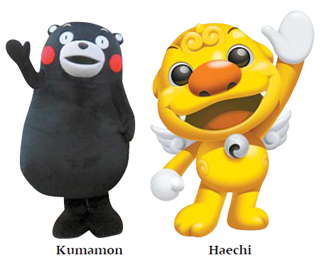Long promotional stall effectively ends Seoul mascot’s run

In 2008, the Seoul Metropolitan Government proudly announced the birth of Haechi, the guardian and mascot of the Korean capital, which the city spent about 5.5 billion won ($4.7 million) to design. The character was selected by city residents in a vote among 20 other animal representations. Haechi, an imaginary horned creature that fights off fire and catastrophe, easily outscored its competitors. The character has a bright yellow face and body and an orange bulbous nose.
The mascot was designed during the tenure of former Seoul Mayor Oh Se-hoon as part of a project known as Design Seoul, while Design Headquarters, an organization specifically designated by the Seoul Metropolitan Government, directed the character’s development.
The city later produced documentaries on the history of the legendary character popular in Chinese and Korean mythology and a number of animations in which the character appears as the protagonist. There are 231 types of Haechi souvenirs, including badges, postcards and wallets.
Yet, after Mayor Park Won-soon was elected in 2011, the Design Headquarters was dismantled and funds were no longer allocated for the mascot’s promotion. Commercial and promotional activities for Haechi abruptly came to a halt.
“We were about to start commercialization activities at the end of 2011,” an official from the Seoul Metropolitan City said. “But after the mayor changed, the plan got washed away.”
In a souvenir shop on the first underground floor of Seoul City Hall, there now remain about 10 Haechi products. All of them are stock items, however, since the production of all commodities related to the character ceased five years ago.
Monthly sales revenue for the souvenirs over the past two years has idled at about 15,000 won ($13).
Since then, city buses designed in 2014 to feature the characters from the Korean animation “Tayo the Little Bus” became instant hits; and following its success, the Seoul Metropolitan Government announced a plan to develop a new official character to represent the capital.
Mascots in other municipalities designed using the local government funds have also met similar fates.
Kkwongdol, the symbol of Wonju, Gangwon, designed in 2005, is one such example.
The character was inspired from a myth about a pheasant that strikes a bell with its head to save a scholar. Now its likeness can hardly be found around the city.
“We’re not encouraging the use of the character since the people in the city weren’t really fond of it,” an official from the Wonju City Government said.
These examples have proven markedly different from the case in Kumamoto Prefecture, Japan, where its official mascot has become the prefecture’s No. 1 promotional commodity.
Kumamon, the prefecture’s character, resembling a black bear, was made in 2011 to promote opening of the region’s high-speed railroad. The character’s likeness appeared frequently at regional events and in press conferences, and the local government even encouraged grocers to put Kumamoto on the packages of their products.
Total sales for souvenirs with Kumamon’s design have so far amounted to one trillion won.
“Kumamon’s design isn’t that outstanding compared to that of Haechi,” said Choi Nak-won, who heads a consulting company. “Instead of discarding the character created by their predecessors, municipal leaders should think of it as a city asset and work to develop it further.”
BY KIM NA-HAN [shin.sooyeon@joongang.co.kr]










with the Korea JoongAng Daily
To write comments, please log in to one of the accounts.
Standards Board Policy (0/250자)